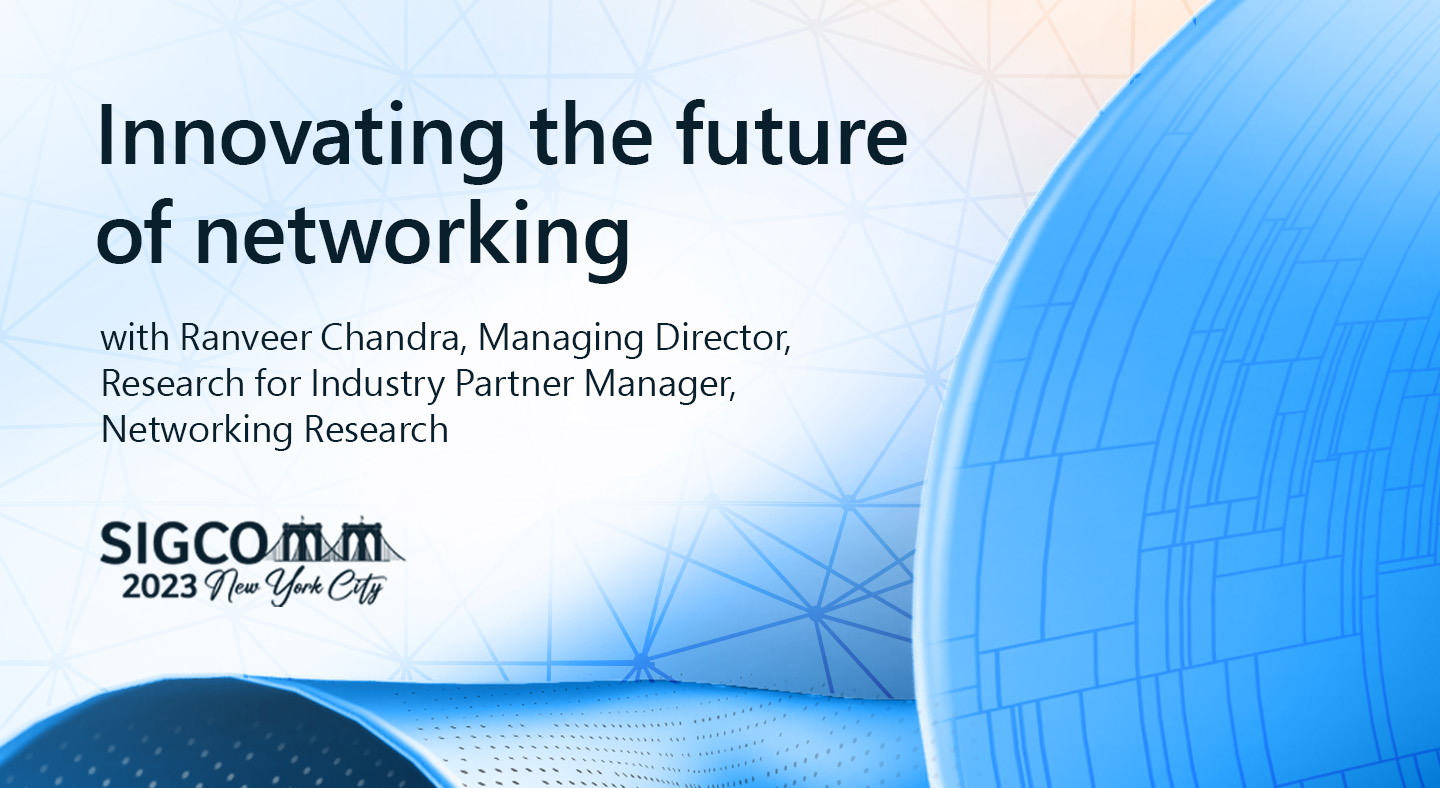
Modern applications heavily rely on robust network infrastructure, requiring continuous innovation. In this evolving landscape, Microsoft is at the forefront, spearheading innovation efforts in networking and strengthening the foundational network infrastructure that underpins the cloud ecosystem. By investing in and enhancing this critical infrastructure, Microsoft not only ensures the resilience and scalability of cloud services but also lays the groundwork for the sophisticated and transformative applications that will continue to define the technological landscape.
ACM SIGCOMM (opens in new tab), the premier annual conference of the Association for Computing Machinery’s special interest group on data communication (opens in new tab) (SIGCOMM), is dedicated to the study of communication and computer networks. Microsoft was proud to be a Gold Sponsor of this year’s conference, publishing 10 papers and participating in the organizing committee. Dave Maltz (opens in new tab), technical fellow and corporate vice president of Azure Networking, served as one of the program committee chairs, helping to oversee the conference’s technical program. Additionally, we are proud to acknowledge the significant achievement of one of our youngest researchers, Siva Kakarla (opens in new tab), recognized as the ACM SIGCOMM Dissertation Award (opens in new tab) runner up for his thesis, “Formal Methods for a Robust Domain Name System (opens in new tab).”
Microsoft also had a booth showcasing some of our latest technologies, including hollow core biber-based connectivity, SoNIC on smart switches, container networking, technologies for L3/L4-based DDoS protection, and technologies that we are building to extend the cloud into space—for both earth observation and satellite communication.
Spotlight: On-Demand EVENT
Microsoft Research Summit 2022
On-Demand
Watch now to learn about some of the most pressing questions facing our research community and listen in on conversations with 120+ researchers around how to ensure new technologies have the broadest possible benefit for humanity.
Paper highlights
The papers Microsoft published at SIGCOMM 2023 span a wide spectrum of networking domains, ranging from 5G and wide area networks (WAN) to enterprise networks. They also explore various aspects of networking, including traffic engineering, network offload strategies, and specialized network designs tailored for applications like gaming, video conferencing, and financial services.
Here are some of the highlights:
Switchboard: Efficient Resource Management for Conferencing Services
Efficient resource management is crucial for conferencing services, such as Microsoft Teams, to balance user experience and cost-effectiveness. This involves optimizing the allocation of media processing servers, responsible for handling media streams during calls. Rahul Bothra, Rohan Gandhi, Ranjita Bhagwan, Venkat Padmanabhan, Rui Liang, Steve Carlson, Vinayaka Kamath, Sreangsu Acharyya, Ken Sueda, Somesh Chaturmohta, and Harsha Sharm introduce Switchboard, a significant advancement in resource management controllers. Switchboard is peak-aware, recognizing that resource costs vary with peak usage times and across time zones, allowing servers to serve calls during peak times and act as backups during off-peak hours. Additionally, it enhances efficiency by coordinating network and compute provisioning and application-aware resource allocation. Evaluation using Microsoft Teams data demonstrates that Switchboard reduces provisioning costs by up to 51 percent while maintaining or improving latency compared to existing solutions.
Resilient Baseband Processing in Virtualized RANs with Slingshot
In the realm of cellular networks, virtualized radio access networks (vRANs) are gaining prominence, replacing traditional specialized hardware with software on commodity servers. However, current vRAN setups lack resilience, making it challenging to implement failover mechanisms and upgrades without prolonged service interruptions. Nikita Lazarev, Tao Ji, Anuj Kalia, Daehyeok Kim, Ilias Marinos, Francis Y. Yan, Christina Delimitrou, Zhiru Zhang, and Aditya Akella propose Slingshot, an innovative system designed to seamlessly introduce resilience to the most critical layer of vRANs, the physical layer (PHY). Slingshot accomplishes this by employing novel techniques for real-time workload migration, incorporating fast RAN protocol middleboxes, and implementing real-time RAN failure detection. A key breakthrough in Slingshot’s design is its approach to treat transient disruptions from resilience events as akin to regular wireless signal impairments, using the inherent resilience of cellular networks to these occurrences. Experiments conducted on a cutting-edge 5G vRAN testbed demonstrate Slingshot’s capability to manage PHY failover without interrupting video conferencing and causing under 110 microseconds of disruption to a TCP connection. Furthermore, it enables seamless zero-downtime upgrades in vRAN deployments.
DBO: Response Time Fairness for Cloud-Hosted Financial Exchanges
When hosting financial exchanges in cloud environments, ensuring equal and predictable latency for all market participants is critical, especially in tasks like high-speed trading. Existing cloud deployments often struggle to maintain such fairness due to factors like congestion and varying network paths. In this paper, Prateesh Goyal, Eashan Gupta, Ilias Marinos, Chenxingyu Zhao, Radhika Mittal, and myself (Ranveer Chandra), tackle the issue arising from the lack of determinism in cloud networks, showing that achieving predictable or bounded latency isn’t a necessity to ensure fairness. Inspired by the concept of logical clocks in distributed systems, the paper introduces Delivery Based Ordering (DBO) as a novel approach to rectifying latency discrepancies among participants, helping ensure fairness. The evaluation of DBO, conducted both in a hardware testbed and a public cloud environment, demonstrates its feasibility in achieving guaranteed fairness and sustaining sub-100 microsecond latency, even at high transaction rates.
For the complete list of accepted publications by Microsoft researchers, please see the publications list on Microsoft at SIGCOMM 2023.

Learn about opportunities
Microsoft welcomes talented individuals across various roles at Microsoft Research, Azure Networking, and other departments. Whether you’re a networking partner or researcher, we welcome your collaboration and exploration to advance computer networking and invite you to be part of the team crafting cutting-edge solutions for industry challenges. Review our open positions at the Microsoft Research website.
The post Microsoft at ACM SIGCOMM 2023: Innovating the future of networking appeared first on Microsoft Research.

